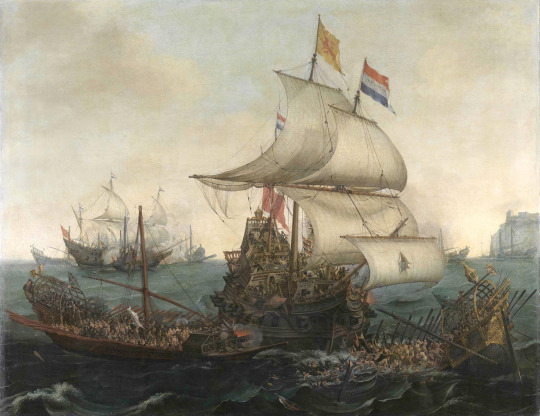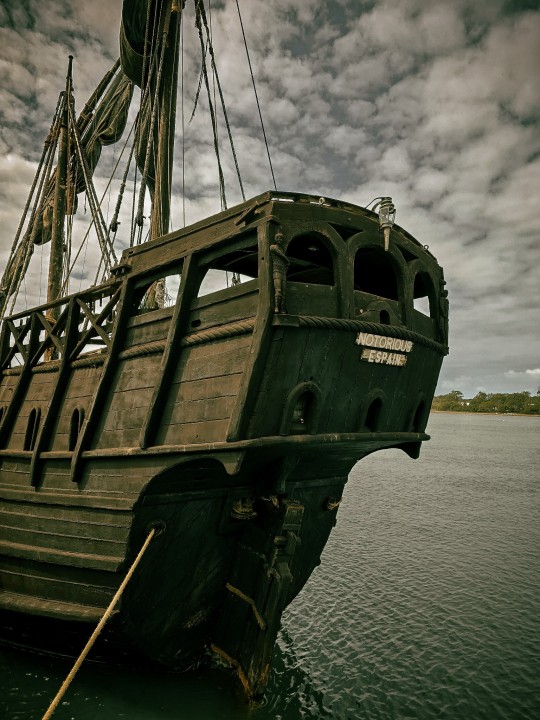#galley
Text




▪︎ Automaton in the form of a galley.
Date: 1626
Artist: Georg Burrer, (turning) (worked in Stuttgart 1598/99-1627), Georg Ernst, (turning work) (died after 1634), Christoph Schorkfel (mechanics)
Medium: Ivory, brass, linen, silk; Movement: iron
709 notes
·
View notes
Text

Stern view of the galley replica "La Real" (La Real was not the name of the ship, but the designation for its function as a flagship), which was the flagship of Juan de Austria at the naval battle of Lepanto 7. October 1571
180 notes
·
View notes
Photo

Function leads, and decoration follows, in this thoughtfully conceived galley kitchen. The double sink, the work space adjoining the range, and the built-in spice shelf are all planned for an active occupant. The tree-branch silhouettes are a gentle vision in a New York City apartment.
Rooms by Design, 1989
#vintage#vintage interior#1980s#interior design#home decor#kitchen#galley#mirrored wall#tree#mural#track lighting#stools#counter#modern#black and white#industrial#style#home#architecture#storage
560 notes
·
View notes
Photo

Meiko Kaji (梶芽衣子) in Female Convict Scorpion: Grudge Song (女囚さそり 701号怨み節), 1973, directed by Yasuharu Hasebe (長谷部安春).
#Meiko Kaji#梶芽衣子#Female Convict Scorpion#Female Prisoner Scorpion#Yasuharu Hasebe#Female Convict Scorpion: Grudge Song#女囚さそり 701号怨み節#長谷部安春#press photo#noose#galley
139 notes
·
View notes
Note
Do we know anything about the historical context that allowed Venice to come up with something like the Arsenal? Most accounts kind of treat it as this de Novo idea to mass produce ships, but I feel like history never actually works like that, and Carthaginians were doing that 1,500 years earlier. Were there trends going on elsewhere in Europe and the Mediterranean world that contributed to this industrial breakthrough? Do we know anything about the specific administrators who had to plan this seeming quantum leap in production out? Did a bunch of folks immediately see what the Venetians were doing and copy it? If not, why?
I'm going to take a slightly broader take on this question: the assembly line is not an invention, it's a discovery. So it's not about who did it first, because you have lots of cases of independent discoveries happening in wildly disparate times and places.
I remember quite vividly a talk given by Professor Anthony Barbieri-Low when he first arrived at UCSB, where he argued that the assembly line was first discovered in China...during the Bronze Age. As early as the Shang and Zhou dynasties around 1000 BCE, we have evidence of assembly line techniques being used in the production of bronze and pottery, because the pieces were inscribed on the bottom with indications of which worker did which parts of the process and which quality inspector signed off on the piece as good enough for sale - so that if the thing broke, officials could figure out exactly who to blame for shoddy work.

So it's not that Venice was the first to ever adopt the idea of assembly line manufacture of ships, but rather that they did it more consistently and devoted more resources to it than anyone else, and iteratively improved on the techniques to get production times down to a single day per galley.
The Arsenal of Venice was an enormous complex, roughly 15% of Venice's landmass, surrounded by a two-mile long defensive wall, and employing some 16,000 people. In addition to standardized pre-fabricated parts, the Arsenal also emphasized division of labor with workshops devoted to producing everything a warship might need in-house - rope, rigging, masts, planking, sails, nails, guns, etc. Organizing these supply chains, what we might call vertical integration, was an incredible logistical feat in and of itself.
In terms of technology, the Arsenal pioneered frame-first (as opposed to hull-first) construction, a moving assembly line whereby galleys were floated down a canal to different stages of the production process, new forms of firearms, and new kinds of ships llike the galleass and galleon. Galileo was a major consultant to the Arsenal at the height of its power.
In addition to the technical advancements, all of this required a lot of money - roughly 10% of the Republic's entire budget - and what made Venice truly unique was its ability to devote those kind of resources on a regular basis at a time when even powerful empires like the Ottomans and the Spanish were still using the yo-yoing methods of medieval fleet construction.
#history#economic history#ancient history#renaissance history#arsenal of venice#galley#ships#medieval navy#royal navies#royal fleets#military history#naval warfare
65 notes
·
View notes
Text

woman (name unknown) smoking while cooking in the galley. I’m assuming she was the resident cook on the ship at the time (which is actually how my mum and dad would meet roughly 15 years after this photo was taken.) I’m not sure which vessel this is, as my father worked on and captained many trawlers throughout his career, but I think it’s a great photo.
#film photography#80’s#smoking#nautical#fishing boats#fisherman#kitchy#kitchen#1980’s#nostalgia#galley#ocean#fishing trawler
15 notes
·
View notes
Photo


Galley at recruit camp, Navy Yard, Puget Sound, 12/22/1917.
Record Group 71: Records of the Bureau of Yards and Docks
Series: Photographs of Construction Progress and Completion of U.S. Naval Shore Installations and Shipyards
Image description: Sailors standing in a galley (kitchen). Large pots and pans hang from the ceiling and sit on a table-sized stove. The sailors stand behind the stove, wearing white uniforms, long aprons, and “dixie cup” hats cocked at various angles.
Image description: Zoomed-in portion of image, showing a sailor sitting on the shelf of a pass-through window to another room, looking over his shoulder at the camera.
#archivesgov#December 22#1917#1910s#World War I#WWI#military#U.S. Navy#USN#Puget Sound#galley#kitchen
50 notes
·
View notes
Text





Commission - Ship's Cook
A Rendered illustration commission for a client, of their TTRPG Wizard pirate character in their galley!
#reubenyeoart#commission#rendered#digital art#character art#fantasy art#illustration#oc#dog#golden retriever#pirate#cook#galley#kitchen#food#bottles#cups#signboard#monkey
6 notes
·
View notes
Text
Episode 4 of the Shogun remake is a good showcase for a specific development in the history of warfare. When galleons, made to survive the rougher conditions of the Atlantic, went up against galleys and small boats made for seas, the ancient tactics of boarding and fighting hand-to hand didn’t work anymore because they were just too tall.

There’s one story of a galleon sailing into the Mediterranean and getting attacked by quinqueremes and galleasses, and when one tried to ram her like it was the Peloponnesian or Punic Wars the galley just crushed herself against the side of the galleon, doing no damage.

#shogun fx#naval battle#galleon#black ship#renaissance#age of sail#spain#portugal#trireme#galley#boarding action#the future is now old man
4 notes
·
View notes
Text



Found this boat just fuckin parked up at the jetty today?? Hello? 👀
2 notes
·
View notes
Photo

The Magic Christian, by Joseph McGrath, 1969.
The ship’s machines
8 notes
·
View notes
Text

A Galley and a Portuguese caravel, detail from the Nautical chart of the Mediterranean, by Grazioso Benincasa, 1482
64 notes
·
View notes
Photo

This upstairs kitchen... built immediately under the rafters of a cinder block home in England. But the architect who designed and owns this house managed to pull light in from the second-story patio by using a glass door and installing a floor-to-ceiling window, eliminating the sold wall that would have kept this galley work area in the dark.
Beyond The Kitchen: A Dreamer’s Guide, 1985
#myfavorites#vintage#vintage interior#1980s#interior design#home decor#kitchen#galley#windows#paper lantern#cinder block#rafters#sliding door#glass#tile floor#natural#industrial#bohemian#style#home
788 notes
·
View notes
Text


Art exhibit 🩷🩷🩷
3 notes
·
View notes
Note
You already guesstimated how much it would cost to maintain a man-at-arms in Westeros, but what about ships? Like longboats, the Iron Fleet's small galleys, the true galleys and dromonds from the Redwynes and the Royal Fleet and the Summer Islands' swan ships; how much would it cost a lord to build, crew and maintain any of these?
You don't ask much, do you? Only a whole bunch of math and research into three different kinds of costs of four different kinds of ships. That comes across a little bit demanding, a little bit entitled.
Tell you what, I'll do it just for a true galley.
Construction Costs
Thankfully, the English fiscal state has fairly good records when it comes to paying its bills. So for example, the so-called "Pipe Roll" records of 1295 have data on the construction costs of building eight galleys of 100 oars. These galleys tended to cost an average of £223 (roughly evenly split between materials costs and labor) - which works out to about 178 golden dragons.
Crew Costs
There is a long and ugly history of galley slaves that wouldn't be allowed given Westerosi prohibition on slavery, so we have to look for historical wages for oarsmen in periods where free wage laborers were used in galleys.
So for example, in the 1530s the Spanish galleys paid 11 reals per month - which works out to 2.75 shillings a month, or £2.75 per year, which works out to 2.2 golden dragons a year per oarsman. With a galley of 100 oars, you're looking at minimum crew costs of 220 dragons a year in oarsmen wages alone (because running a galley requires food and drink, cordage and chandlery, wages for the sailors and the marines, etc).
Maintenance Costs
So I managed to find some Genoese sources on maintenance costs for galleys - in 1528, Genoa was spending about 5,000 ducats a year in maintenance per galley. That works out to £500 a year, which works out to 400 golden dragons a year.
Conclusion:
In total, that suggests that a lord would have to spend 178 dragons to build a galley, and at least 620 dragons to operate that galley for a year.
43 notes
·
View notes
Video
youtube
12 notes
·
View notes